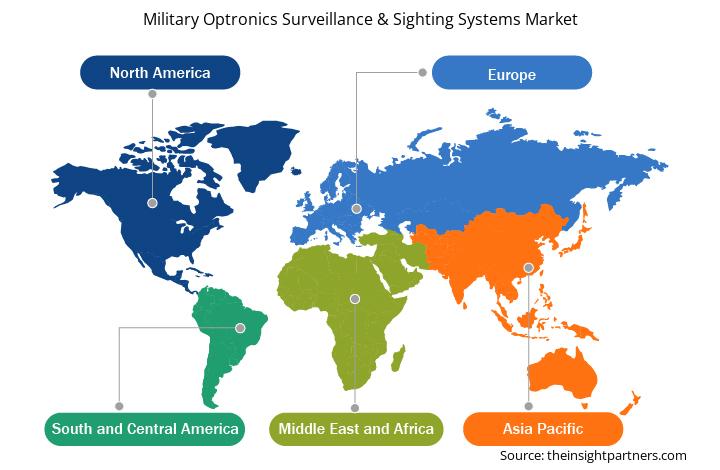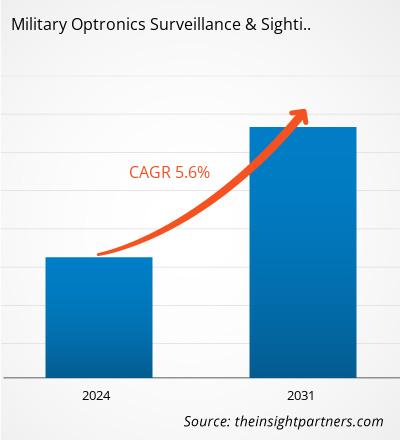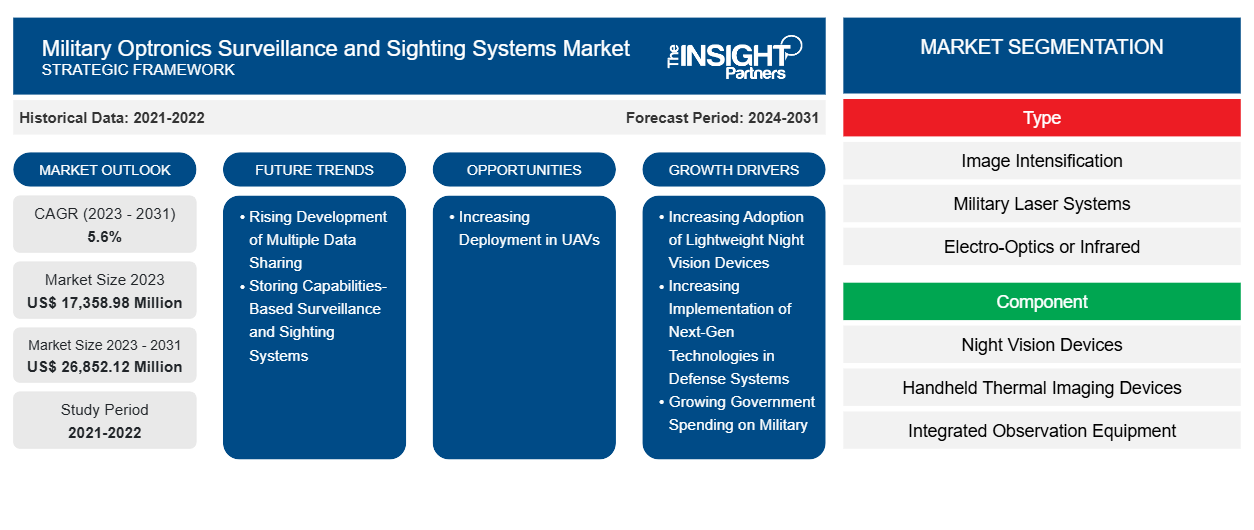군사용 광학 감시 및 조준 시스템 시장 규모는 2023년 17,358.98백만 달러에서 2031년까지 26,852.12백만 달러에 도달할 것으로 예상됩니다. 이 시장은 2023-2031년 동안 5.6%의 CAGR을 기록할 것으로 예상됩니다. 다중 데이터 공유 및 저장 기능 기반 감시 및 조준 시스템의 개발이 증가함에 따라 향후 몇 년 동안 시장에 새로운 주요 트렌드가 나타날 가능성이 높습니다.
군용 광학 감시 및 조준 시스템 시장 분석
혁신이 증가하고 야간 테러 공격의 위협이 커지면서 야간 투시 장치 채택이 증가하고 있습니다. 마찬가지로 열 화상은 군인이 시야가 좋지 않은 조건에서도 표적을 찾는 데 도움이 됩니다. 열 화상 야간 투시 장치는 전 세계적으로 인기를 얻고 있으며, 개별 전투원 시스템을 강화하고 있습니다. 야간 투시 장치는 야간 작전 중에 주변을 밝혀 군인에게 더 큰 상황 인식을 제공합니다. 첨단 기술 기반 경량 야간 투시 장치를 개발하고 채택하려는 정부 이니셔티브가 증가하면서 군용 광학 감시 및 조준 시스템 시장 성장에 대한 수요가 엄청나게 증가했습니다. 예를 들어, 2022년 1월, 미국 국방부 산하 방위 고등 연구 계획국(DARPA)은 미국 군인을 위한 경량 야간 투시 광학 장치를 개발하기 위해 10개의 국방 및 대학 연구팀을 선정했습니다. 이 부서는 야간 투시 시스템을 개발하기 위해 새로운 기술을 채택하기 위해 안경 형태의 향상된 야간 투시(ENVision) 프로그램을 설계했습니다.
주변 국가로부터 영토를 보호하기 위해 전 세계적으로 무인 항공기(UAV)의 배치가 증가함에 따라 예측 기간 동안 광전자 감시 및 조준 시스템 시장이 성장할 수 있는 충분한 기회가 생길 것으로 예상됩니다. 예를 들어, 2022년에 인도군은 Searcher Mark II라는 이름의 이스라엘산 무인 항공기 25대 이상을 처음으로 배치했습니다. 게다가 2024년 5월에 미국 정부는 중국의 방위 능력에 대응하기 위한 정부 프로그램의 일환으로 군에 무인 항공기를 인도하기 시작했습니다. 또한 2023년 3월에 중국의 과학자들은 공중에서 6개의 분리된 유닛으로 빠르게 분리될 수 있는 군용 무인 항공기를 개발했습니다. 이러한 무인 항공기는 공기 분리 기술로 만들어졌습니다. 여러 국가 정부의 무인 항공기에 대한 투자와 배치가 증가함에 따라 예측 기간 동안 광전자 감시 및 조준 시스템 시장에 충분한 기회가 생길 것으로 예상됩니다.
군용 광학 감시 및 조준 시스템 시장 개요
군용 광학, 감시 및 조준 시스템은 공중, 지상 및 해상 전쟁 환경에서 위협을 식별, 추적, 모니터링 및 공격할 수 있는 충분한 도구를 인력에 제공합니다. 이러한 시스템은 고성능 광학 구성 요소와 고급 센서를 통합하여 군대에 정밀한 탐지, 인식 및 표적 식별과 상황 인식을 제공합니다. 또한 광학, 감시 및 조준 시스템은 국경 통제, 기지 보호, 정찰 및 정보 수집 임무 요구 사항을 충족하는 데 적용됩니다. 광학 및 감시 시스템의 기술적 발전과 방위군이 기존 장비와 시스템을 업그레이드해야 하는 지속적인 수요가 결합되어 글로벌 군용 광학, 감시 및 조준 시스템 시장을 주도하고 있습니다.
귀하의 요구 사항에 맞게 이 보고서를 사용자 정의하세요
이 보고서의 일부 또는 국가 수준 분석, Excel 데이터 팩을 포함하여 모든 보고서에 대한 사용자 정의를 무료로 받을 수 있으며 신생 기업 및 대학을 위한 훌륭한 혜택과 할인 혜택을 이용할 수 있습니다.
-
이 보고서의 주요 시장 동향을 알아보세요.이 무료 샘플에는 시장 동향부터 추정 및 예측까지 다양한 데이터 분석이 포함됩니다.
군사용 광학 감시 및 조준 시스템 시장 동인 및 기회
가벼운 야간 투시 장치 채택 증가
혁신이 증가하고 야간 테러 공격의 위협이 커지면서 야간 투시 장치 채택이 증가하고 있습니다. 이전에는 야간 투시 장치가 비교적 무거운 구성 요소를 사용하여 군인의 무게를 늘렸습니다. 다양한 시장 참여자가 이제 가벼운 야간 투시 제품을 출시하고 있습니다. 예를 들어, ACTinBlack은 높은 광학 성능과 인체공학적 디자인을 갖춘 가벼운 쌍안경 야간 투시 장치를 개발했습니다. 2023년 10월, 미국에 본사를 둔 열 화상 및 증강 현실(AR) 회사인 Thermoteknix Systems는 고급 증강 현실(FNVG-AR)을 갖춘 Fused Night Vision Goggle이라는 야간 투시 솔루션을 출시했습니다. FNVG-AR 시스템은 첨단 기술 기반 차세대 16mm 백색 인광체 야간 투시 튜브와 고해상도 열 화상 장치가 통합된 가벼운 쌍안경 야간 투시 고글(NVG)입니다.
무인 항공기(UAV) 배치 증가
무인 시스템은 인명 위험을 줄여 전 세계 군대의 필수적인 부분이 되었습니다. 무인 항공기(UAV)가 제공하는 다양한 이점으로 인해 미국, 인도, 중국과 같은 많은 국가는 주로 감시 애플리케이션을 위해 군대에 더 많은 UAV를 배치하기 위해 상당한 예산을 할당했습니다. 무인 플랫폼에 광전자 감시 및 조준 시스템을 배치하면 감시 및 영상 데이터 전송이 용이해집니다. 무인 시스템을 통신 안테나 및 기타 감시 장비와 통합하면 다양한 중요한 임무에 도움이 됩니다. 따라서 공중 및 해군 감시 및 매핑 임무를 위한 UAV의 배치가 증가함에 따라 전반적인 효율성을 저해하지 않고 UAV 플랫폼에 효과적으로 통합할 수 있는 광전자 감시 및 조준 시스템에 대한 필요성이 커지고 있습니다. 따라서 Rafael Advanced Defense Systems Ltd. 및 Lockheed Martin을 포함한 군용 광전자 감시 및 조준 시스템 시장의 몇몇 주요 산업 기업은 UAV 플랫폼용 광전자 감시 및 조준 시스템을 개발하고 제공하는 데 중점을 둡니다.
군용 광학 감시 및 조준 시스템 시장 보고서 세분화 분석
군사 광학 감시 및 관측 시스템 시장 분석 도출에 기여한 주요 세그먼트는 다음과 같습니다.유형, 구성요소 및 최종 사용자.
- 군용 광학 감시 및 조준 시스템 시장은 유형에 따라 영상 강화, 군용 레이저 시스템, 전기 광학/적외선으로 분류됩니다. 전기 광학 부문은 2023년에 시장에서 가장 큰 점유율을 차지했습니다.
- 구성 요소별로 시장은 야간 투시 장치, 핸드헬드 열 화상 장치, 통합 관측 장비, 독립형 적외선, 지진 및 음향 센서, 기타로 분류됩니다. 지진 및 음향 센서 부문은 2023년에 시장을 지배했습니다.
- 최종 사용자 측면에서 군용 광학 감시 및 조준 시스템 시장은 지상, 공중 및 해군으로 분류됩니다. 지상 세그먼트는 2023년에 시장에서 가장 큰 점유율을 차지했습니다.
군용 광학 감시 및 조준 시스템 시장 점유율 분석
군사 광학 감시 및 조준 시스템 시장 보고서의 지리적 범위는 자세한 글로벌 분석을 제공합니다. 북미, 유럽 및 아시아 태평양은 군사 광학 감시 및 조준 시스템 시장에서 상당한 성장을 목격하는 주요 지역입니다. 북미의 군사 광학 감시 및 조준 시스템 시장은 미국, 캐나다 및 멕시코로 세분화됩니다. 2023년에 미국은 북미의 군사 광학 감시 및 조준 시스템 시장을 지배했으며 2023년에 상당한 시장 점유율을 차지했고 그 뒤를 캐나다와 멕시코가 따랐습니다. 이러한 선진 경제는 GDP의 상당 부분을 군사 지출에 지출합니다. 공식적으로 인정된 출처에서 수집한 세계은행 개발 지표 컬렉션에 따르면 미국의 군사 지출은 2023년에 GDP의 약 3.5%로 보고되었습니다. 또한 미국 연방 예산부에 따르면 2023 회계연도에 미국 정부는 국방 부문에 8,200억 달러를 지출했습니다. 이 금액은 미국 연방 지출의 13%로 추산되었습니다. 시장의 주요 업체들은 공중 옵트로닉스 감시 시스템, 고급 디지털 열 화상 카메라, 추적 및 검색 시스템 등을 기반으로 하는 첨단 기술을 개발하고 있습니다. 예를 들어, 미국에 본사를 둔 Obsidian Sensors Inc.는 저렴한 고해상도 센서를 사용하여 열 화상을 처리하는 새로운 기술을 2023년에 출시했습니다.
군용 광학 감시 및 조준 시스템 시장 지역 통찰력
Insight Partners의 분석가들은 예측 기간 동안 군용 광학 감시 및 조준 시스템 시장에 영향을 미치는 지역적 추세와 요인을 철저히 설명했습니다. 이 섹션에서는 또한 북미, 유럽, 아시아 태평양, 중동 및 아프리카, 남미 및 중미 전역의 군용 광학 감시 및 조준 시스템 시장 세그먼트와 지리에 대해서도 설명합니다.

- 군용 광학 감시 및 조준 시스템 시장을 위한 지역별 특정 데이터 얻기
군용 광학 감시 및 조준 시스템 시장 보고서 범위
| 보고서 속성 | 세부 |
|---|---|
| 2023년 시장 규모 | 17,358.98백만 달러 |
| 2031년까지 시장 규모 | 26,852.12백만 달러 |
| 글로벌 CAGR (2023-2031) | 5.6% |
| 역사적 데이터 | 2021-2022 |
| 예측 기간 | 2024-2031 |
| 다루는 세그먼트 |
유형별로
|
| 포함된 지역 및 국가 |
북아메리카
|
| 시장 선도 기업 및 주요 회사 프로필 |
|
군용 광학 감시 및 조준 시스템 시장 참여자 밀도: 비즈니스 역학에 미치는 영향 이해
군용 광학 감시 및 조준 시스템 시장은 소비자 선호도의 변화, 기술 발전, 제품의 이점에 대한 인식 증가와 같은 요인으로 인해 최종 사용자 수요가 증가함에 따라 빠르게 성장하고 있습니다. 수요가 증가함에 따라 기업은 제품을 확장하고, 소비자의 요구를 충족하기 위해 혁신하고, 새로운 트렌드를 활용하여 시장 성장을 더욱 촉진하고 있습니다.
시장 참여자 밀도는 특정 시장이나 산업 내에서 운영되는 회사나 기업의 분포를 말합니다. 주어진 시장 공간에 얼마나 많은 경쟁자(시장 참여자)가 존재하는지 그 규모나 전체 시장 가치에 비해 나타냅니다.
군용 광학 감시 및 조준 시스템 시장에서 운영되는 주요 회사는 다음과 같습니다.
- 에어버스
- 록히드 마틴 주식회사
- 탈레스 그룹
- 제너럴 다이내믹스 코퍼레이션
- L3해리스 테크놀로지 주식회사
- 이스라엘 항공우주산업
면책 조항 : 위에 나열된 회사는 어떤 특별한 순서에 따라 순위가 매겨지지 않았습니다.

- 군사 광학 감시 및 조준 시스템 시장 주요 주요 업체 개요를 알아보세요
군용 광학 감시 및 조준 시스템 시장 뉴스 및 최근 개발
군용 옵트로닉스 감시 및 조준 시스템 시장은 1차 및 2차 연구 이후의 정성적, 정량적 데이터를 수집하여 평가합니다. 여기에는 중요한 기업 간행물, 협회 데이터 및 데이터베이스가 포함됩니다. 군용 옵트로닉스 감시 및 조준 시스템 시장의 몇 가지 개발 사항은 다음과 같습니다.
- 센서 전문 기업 HENSOLDT는 PUMA 보병 전투 차량에 최첨단 광학 비전 시스템을 공급하고 있습니다. 고객은 PUMA 보병 전투 차량을 생산하고 공동으로 설립한 PSM GmbH를 통해 유통하는 시스템 하우스인 KNDS와 Rheinmetall입니다. 주문 가치는 백만 달러에 달합니다. 보병 전투 차량의 포탑 비전 시스템 외에도 이 주문에는 훈련 차량 승무원을 위한 12대의 포탑 트레이너 장비가 포함됩니다. HENSOLDT는 이 납품을 통해 K-Stand S1에서 PUMA를 개선하는 데 도움을 주고 있습니다. (출처: HENSOLDT, 보도 자료, 2024년 6월)
- 프랑스군은 Bi-NYX 계약의 일환으로 2020년 프랑스 국방 조달 기관(DGA)이 주문한 Thales 야간 투시경 300개를 처음 받았습니다. DGA에 인도된 300개의 고글은 2023년 12월에 주문한 2,000개 세트의 첫 번째 배치입니다. 나머지 1,700개는 올해 말까지 배송될 예정입니다. (출처: Thales, 보도자료, 2024년 10월)
군용 광학 감시 및 조준 시스템 시장 보고서 범위 및 제공물
"군사 광학 감시 및 조준 시스템 시장 규모 및 예측(2021-2031)" 보고서는 다음을 포함하는 시장에 대한 자세한 분석을 제공합니다.
- 범위에 포함된 모든 주요 시장 부문에 대한 국가 수준의 군사 광학 감시 및 관찰 시스템 시장 규모 및 예측
- 군용 광학 감시 및 관찰 시스템 시장 동향과 운전자, 제지장치 및 주요 기회와 같은 시장 역학
- 자세한 PEST 및 SWOT 분석
- 주요 시장 동향, 국가 프레임워크, 주요 참여자, 규정 및 최근 시장 개발을 포괄하는 군용 광학 감시 및 관찰 시스템 시장 분석
- 시장 집중도, 히트맵 분석, 유명 업체, 군용 광학 감시 및 관측 시스템 시장의 최근 개발 사항을 다루는 산업 환경 및 경쟁 분석
- 자세한 회사 프로필
- 과거 분석(2년), 기준 연도, CAGR을 포함한 예측(7년)
- PEST 및 SWOT 분석
- 시장 규모 가치/거래량 - 글로벌, 지역, 국가
- 산업 및 경쟁 환경
- Excel 데이터세트
최근 보고서
관련 보고서
사용 후기
구매 이유
- 정보에 기반한 의사 결정
- 시장 역학 이해
- 경쟁 분석
- 고객 인사이트
- 시장 예측
- 위험 완화
- 전략 기획
- 투자 타당성 분석
- 신흥 시장 파악
- 마케팅 전략 강화
- 운영 효율성 향상
- 규제 동향에 발맞춰 대응























 무료 샘플 받기 - 군용 광학 감시 및 조준 시스템 시장
무료 샘플 받기 - 군용 광학 감시 및 조준 시스템 시장